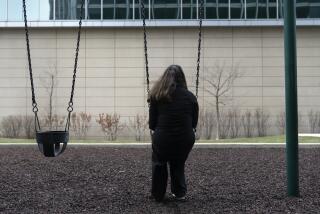Youngsters Deal With Stress in Their Own Ways
- Share via
SAN FRANCISCO — Doctors puzzled over the symptoms of an 8-year-old boy who was suffering from chronic headaches--until they asked him to describe his pain.
“It feels like my heart is in my head,” replied the boy, whose parents had recently divorced and whose father moved away at about the same time his complaints began.
The headaches were eventually diagnosed as psychosomatic--a reaction to emotional stress--although the pain was very real to the boy, who thought it was being caused by a new pair of glasses.
“His answer was a metaphorical way of expressing a broken heart,” said W. Thomas Boyce, a physician and director of the Child Study Unit at UC San Francisco Medical Center.
React in Different Ways
Youngsters of all ages come under varying amounts of negative stress and react to it in different ways, headaches being one of the more common manifestations.
Preschoolers and young children often become physically ill or inattentive, or suddenly turn aggressive; teen-agers are often self-destructive, turning to alcohol and drugs or even suicide.
Divorce is one of the leading stress factors, said Boyce, whose unit specializes in dealing with behavioral problems and learning disabilities of children from infancy to early adolescence.
Other stress factors include a death in the family, residential mobility, spending little time with busy parents, family pressures to excel in academics, sports or social skills, and mixed messages on how to relate to sex, drugs and money.
Spending time with children is very important, not just so-called quality time but lots of time, Boyce said. This is often difficult, he said, because of the growing number of two-wage-earner families and single-parent families.
“A lot of the problem is not neglect; it’s dealing with the exigencies of life, the demands of work and of just living,” said Boyce, who nevertheless believes that the responsibilities of guiding and helping children rests primarily with the family.
Signs of stress are different for each age group, Boyce said, but parents should be alert to such symptoms as depression, usually in the form of withdrawal; acting out anger by unusual aggressive behavior; poor school performance, or continuing illness or pain.
He prescribes the following anti-stress measures for parents:
- Spend more time with children.
- Maintain regularity and predictability in their lives.
- Help children adapt slowly to changes; lessen disruptions, perhaps by not moving immediately after a divorce.
- Encourage play and fantasy as a way of coping.
VeLora Lilly, a clinical social worker and psychologist at the Alta Bates Herrick Hospital and Health Center in Berkeley, said adolescents are often vulnerable to stressful situations in the family.
‘They’re Fairly Impulsive’
“Teen-agers are quite reactive to a lot of situations that adults might not relate to,” said Lilly, program coordinator of the adolescent psychiatric unit that provides inpatient services for teen-agers and their families. “They’re fairly impulsive. They have a different way of looking at the world and are more reactive to upsets.”
About half a million young people ages 12 to 24 attempted suicide last year and an estimated 7,000 took their own lives, but these figures are only the most alarming examples of youth under stress, Lilly said.
Many depressed young people turn to drugs or alcohol and are considered potentially at risk or suicidal because of their self-destructive behavior. Some children from upper-middle-class families, Lilly said, develop eating disorders--anorexia or bulimia--that psychologists relate to suicidal behavior.
“The kids are killing themselves, only slowly,” Lilly said. “The reasons are often very subtle, a feeling of powerlessness, fear of growing up or parents maybe over-involved in their lives, which is as toxic as being under-involved. They try to gain control by controlling what they put in their mouths.”
One teen-age girl, she said, took an overdose of medication with the intent of killing herself and was brought to the clinic, where she revealed that she had broken up with a boyfriend, had two pregnancies aborted, lost her parents and had been shuffled among relatives.
“It’s a typical case and very common,” said Lilly, who believes that funds should be funneled into support programs, especially in the schools, to help such youngsters.
“The way things are set up, a youngster has to be in a critical state to be admitted to a hospital program, and that often means they have to risk their lives to get the help they need,” she said.
“If we could provide something short of that in the community, they would have an alternative to desperate acts.”
More to Read
Sign up for Essential California
The most important California stories and recommendations in your inbox every morning.
You may occasionally receive promotional content from the Los Angeles Times.










